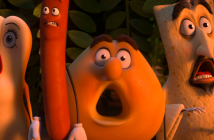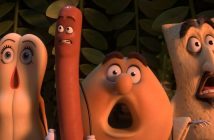
Editor’s Note: Pete’s Dragon opens in wide theatrical release today, August 12, 2016.
A remake of a lightly regarded, little remembered live action/animation family-oriented film seems like an unlikely path for a major Hollywood studio to pursue, but the economics of big-budget filmmaking dictate otherwise. Remakes, reboots, and sequels, not to mention prequels and spinoffs, remain the norm, not the exception, but not all remakes, reboots, and sequels are made alike. Some are better than others; some are worse. Most are middling. Despite studio controls that dictate filmmaking by committee and generic, template filmmaking, sometimes – not often, but sometimes – a big-budget, spectacle-driven film emerges from a major studio, one part mystery, one part miracle. It’s an apt description for indie writer-director David Lowery’s (Ain’t Them Body Saints) latest film, Pete Dragon, a family-oriented fantasy/adventure that features one of the most poignant, moving relationships in recent memory – and one side of that relationship doesn’t even exist. He’s a big, green, furry dragon.
The influence of Lowery’s indie roots – character first, story second, spectacle third – are just as evident in his approach to an often overlooked aspect of big-budget filmmaking: acting.
 The title alone, Pete’s Dragon, suggests that Elliot, the mysterious dragon who saves Pete (Oakes Fegley) from near-certain death after Pete’s parents die in a tragic accident – due, no less to an peripatetic deer (echoes of another Disney classic, Bambi) – somehow “belongs” to Pete, but the opposite holds true as well. Lowery and his co-screenwriter, Toby Halbrooks, leave Elliot’s origins unexplained, but after saving Pete, their relationship deepens into a mutually reciprocal friendship, paralleling the relationship a child or an adult implicitly develops with a family pet. With his grunts and growls, shambling gait, and playfulness, Elliot’s behavior elevates him into something both familiar (he’s a dog) and strange (he’s a dragon). Later, when a perplexed, distraught Pete unwilling reenters human society, Elliot does what any loyal canine would do: He follows every clue, sniffing out every lead to find his friend again.
The title alone, Pete’s Dragon, suggests that Elliot, the mysterious dragon who saves Pete (Oakes Fegley) from near-certain death after Pete’s parents die in a tragic accident – due, no less to an peripatetic deer (echoes of another Disney classic, Bambi) – somehow “belongs” to Pete, but the opposite holds true as well. Lowery and his co-screenwriter, Toby Halbrooks, leave Elliot’s origins unexplained, but after saving Pete, their relationship deepens into a mutually reciprocal friendship, paralleling the relationship a child or an adult implicitly develops with a family pet. With his grunts and growls, shambling gait, and playfulness, Elliot’s behavior elevates him into something both familiar (he’s a dog) and strange (he’s a dragon). Later, when a perplexed, distraught Pete unwilling reenters human society, Elliot does what any loyal canine would do: He follows every clue, sniffing out every lead to find his friend again.
Pete’s reentry into society – a bucolic, welcoming Pacific Northwest (actually New Zealand) remarkably, blissfully free of the steady hum and glow of electronic appurtenances – happens almost inadvertently. Frolicking near an area being cleared by a lumber company (insert environmental message here), Pete’s natural curiosity gets the better of him when he spots an age-appropriate girl, Natalie (Oona Laurence). Natalie reciprocates Pete’s curiosity, but before long, well-meaning adults step in. Natalie’s soon-to-be stepmother, Grace (Bryce Dallas Howard), a forest ranger, takes an instant interest in Pete while Natalie’s uncle, Gavin (Karl Urban), the personification of corporate greed first sees Elliot as a threat and later as an economic opportunity. Gavin might be the closest Pete’s Dragon comes closest to a villain, but even his villainy isn’t wholly one-dimensional. For all of his bluster, he steps in when he sees danger (or thinks he sees danger). Natalie’s father, Jack (Wes Bentley), embodies the admittedly limited “Good Dad” trope. He’s practically perfect, if too forgiving of his brother’s actions.
Lowery doesn’t skimp on spectacle, especially early on when he’s content to let the camera follow Pete and Elliot on one of their many adventures through the forest, but he also doesn’t go for the big, thrilling set pieces typical of big-budget filmmaking. Even when the plot forcibly separates Pete and Elliot, he gives Pete a brief “running amok” scene while Elliot flies over the town, searching for Pete. Lowery only amps up the action – relatively speaking – when Pete’s Dragon takes a turn into familiar King Kong territory. But Lowery, an indie filmmaker at heart, cares less about impressing moviegoers with visual effects and more about moving them with emotional ones and there he amply succeeds, repeatedly returning to Pete and Elliot’s core relationship. Lowery also recognizes that with time and new relationships – here a human family for the orphan Pete – other, older relationships have to change and evolve too.
Lowery doesn’t skimp on spectacle, especially early on when he’s content to let the camera follow Pete and Elliot on one of their many adventures through the forest, but he also doesn’t go for the big, thrilling set pieces typical of big-budget filmmaking.
The influence of Lowery’s indie roots – character first, story second, spectacle third – are just as evident in his approach to an often overlooked aspect of big-budget filmmaking: acting. Lowery elicits fine, convincing performances from his entire cast, but deserves special credit for getting a relatively grounded, affectation-free performance from his two youngest actors, Oakes Fegley and Oona Lawrence. Lawrence is already a known commodity, giving a remarkably assured performance in last year’s boxing melodrama, Southpaw. Fegley hasn’t had to carry large sections of a film before, but he does so here, especially considering the absence of his green, furry co-star. In Elliot, easily one of the most expressive, emotive CGI creature creations put on film, Lowery has the only real visual effect he needs to turn Pete’s Dragon from an eyebrow raising curio (the general reaction when news broke of Lowery’s involvement in a remake of a decades-old Disney property) to more than just a pleasant, late-summer surprise. It’s also a welcome one.
In Pete's Dragon, director David Lowery has turned what could have been just an eyebrow-raising curio into a welcome late-summer surprise.



